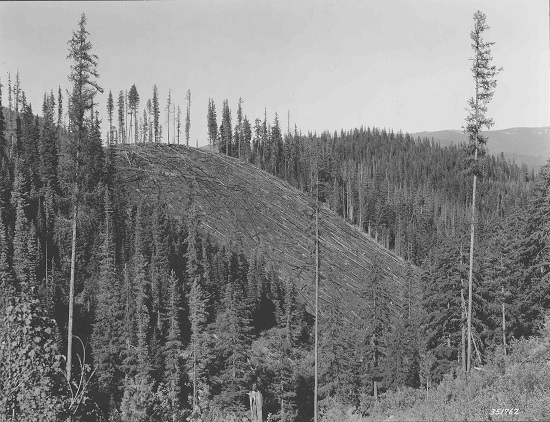 Deception Creek Experimental Forest is one of the most productive forests in the Rocky Mountains. The forest is 3,520 acres, with elevations ranging from 2,790 to 4,600 feet. Because this forest, located in the Coeur d'Alene Mountains, represents the heart of the western white pine (Pinus monticola) forest type, the ecology and silviculture of this ecosystem has been a primary research focus. When the forest was established in 1933, large, old-age western white pine was used extensively by the timber industry.
Deception Creek Experimental Forest is one of the most productive forests in the Rocky Mountains. The forest is 3,520 acres, with elevations ranging from 2,790 to 4,600 feet. Because this forest, located in the Coeur d'Alene Mountains, represents the heart of the western white pine (Pinus monticola) forest type, the ecology and silviculture of this ecosystem has been a primary research focus. When the forest was established in 1933, large, old-age western white pine was used extensively by the timber industry.
Today 80% of the forest is dominated by western hemlock (Tsuga heterophylla). Other common tree species include grand fir (Abies grandis), Douglas-fir (Pseudotsuga menziesii), western larch (Larix occidentalis), and western white pine.
Research and Resources -
Fire Communication & Education: History of fire research as related to experimental forests - One-hundred years of wildfire research: a legacy of the Priest River, Deception Creek, and Boise Basin Experimental Forests of Idaho
Fire & Future Climate: Views on climate change, adaptation strategies, long-term observations to inform research - Experimental forest and climate change: views of long-term employees on ecological change and the role of Experimental Forests and Ranges in understanding and adapting to climate change
Fuels Assessment & Monitoring: Canopy characteristics as related to western white pine growth - Western white pine growth relative to forest openings
Fuel Treatments & Prescriptions: Fuel consumption from burning logging slash in wet mixed-conifer forests - Predicting duff and woody fuel consumption in northern Idaho prescribed fires
Management Approaches: Research changes and management developments over time as agency and public priorties evolve - Northern Rocky Mountain Experimental Forests: settings for science, management, and education alliances
Restoration: History of western white pine loss and management strategies to restore populations - White pine in the American West: a vanishing species - can we save it?